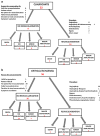A 5-Year Follow-up Study to Assess Clinical Outcomes of Patients with Diabetes Undergoing Lower Limb Angiography for Significant Peripheral Artery Disease
- PMID: 26386883
- PMCID: PMC4674466
- DOI: 10.1007/s13300-015-0131-1
A 5-Year Follow-up Study to Assess Clinical Outcomes of Patients with Diabetes Undergoing Lower Limb Angiography for Significant Peripheral Artery Disease
Abstract
Introduction: The optimal management for patients with diabetes and peripheral vascular disease-intermittent claudication or critical limb ischemia (CLI)-remains undetermined.
Methods: In a single-center retrospective analysis, we compared 1- and 5-year amputation-free survival rates in patients undergoing angiography subsequently treated with medical therapy or revascularization.
Results: 78 patients were included, 56 with CLI (mean age 77 years); 22 with claudication (mean age 75 years). Of the CLI cohort, 30 patients were medically treated. Their 1-year amputation-free survival rate was similar to those treated with revascularization (46.7% versus 50.0%, respectively). 8 patients in the claudicant cohort were treated conservatively. The 1-year amputation-free survival rate was 75.0% for conservative treatment versus 78.6% in those revascularized. Within the CLI cohort, in those conservatively treated 20% underwent major, and 16.7% minor amputations, compared to 15.4% and 23.1% in those revascularized. At 5 years in the claudicant cohort, the amputation-free survival rate was 37.5% with medical treatment, versus 71.4% for those treated with revascularization. For CLI, the 5-year amputation-free survival rate was 10% for conservative treatment, versus 26.9% for revascularization.
Conclusion: We found similar rates of amputation at 1 year for patients treated medically or revascularized. However, at 5 years, the amputation-free survival rate was markedly higher in revascularized patients compared to those medically managed. Our study highlights the potential role of predicting life expectancy when considering treatment, with the option of surgical treatment offered to those in whom survival is predicted to be longer than 5 years. However, larger studies with matched cohorts are now needed to confirm these findings.
Keywords: Amputation; Angiography; Diabetes; Peripheral vascular disease.
Figures
Similar articles
-
Postoperative outcomes for patients undergoing elective revascularization for critical limb ischemia and intermittent claudication: a subanalysis of the Coronary Artery Revascularization Prophylaxis (CARP) trial.J Vasc Surg. 2006 Jun;43(6):1175-82. doi: 10.1016/j.jvs.2005.12.069. J Vasc Surg. 2006. PMID: 16765234 Clinical Trial.
-
Nationwide Trends of Hospital Admission and Outcomes Among Critical Limb Ischemia Patients: From 2003-2011.J Am Coll Cardiol. 2016 Apr 26;67(16):1901-13. doi: 10.1016/j.jacc.2016.02.040. Epub 2016 Mar 21. J Am Coll Cardiol. 2016. PMID: 27012780
-
Contemporary cardiovascular risk and secondary preventive drug treatment patterns in peripheral artery disease patients undergoing revascularization.J Vasc Surg. 2016 Oct;64(4):1009-1017.e3. doi: 10.1016/j.jvs.2016.03.429. Epub 2016 May 18. J Vasc Surg. 2016. PMID: 27209402
-
Efficacy Outcomes of Endovascular Versus Surgical Revascularization in Critical Limb Ischemia: Results From a Prospective Cohort Study.Angiology. 2018 Sep;69(8):677-685. doi: 10.1177/0003319717750486. Epub 2018 Jan 21. Angiology. 2018. PMID: 29355026
-
The benefit of revascularization in nonagenarians with lower limb ischemia is limited by high mortality.Eur J Vasc Endovasc Surg. 2015 Apr;49(4):420-5. doi: 10.1016/j.ejvs.2014.12.027. Epub 2015 Feb 16. Eur J Vasc Endovasc Surg. 2015. PMID: 25698087
Cited by
-
Phase I/IIa Feasibility Trial of Autologous Quality- and Quantity-Cultured Peripheral Blood Mononuclear Cell Therapy for Non-Healing Extremity Ulcers.Stem Cells Transl Med. 2022 Mar 17;11(2):146-158. doi: 10.1093/stcltm/szab018. Stem Cells Transl Med. 2022. PMID: 35298656 Free PMC article. Clinical Trial.
References
-
- International Diabetes Federation. IDF diabetes estimates. 2014. http://www.idf.org/atlasmap/atlasmap. Accessed Aug 28, 2015.
-
- Johannesson A, Larsson G-U, Ramstrand N, Turkiewicz A, Wirehn A-B, Atroshi I. Incidence of lower-limb amputation in the diabetic and nondiabetic general population. A 10-year population-based cohort study of initial unilateral and contralateral amputations and reamputations. Diabetes Care. 2009;32:275–280. doi: 10.2337/dc08-1639. - DOI - PMC - PubMed
-
- Kerr M. Foot care for people with diabetes: The economic case for change. 2012. https://www.diabetes.org.uk/Documents/nhs-diabetes/footcare/footcare-for.... Accessed Jul 20, 2015.
LinkOut - more resources
Full Text Sources
Other Literature Sources
Research Materials
Miscellaneous


